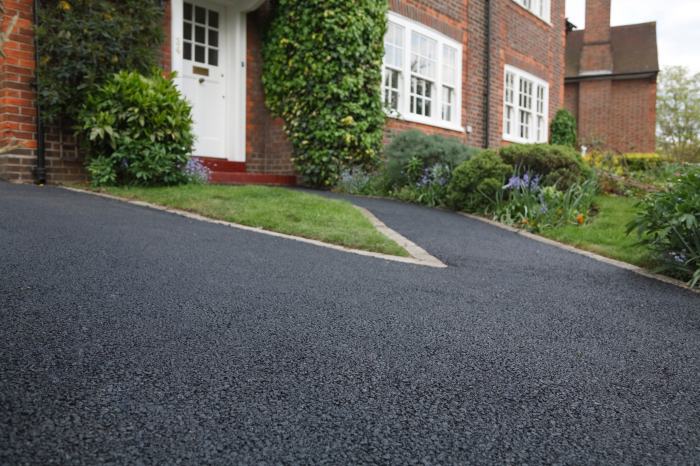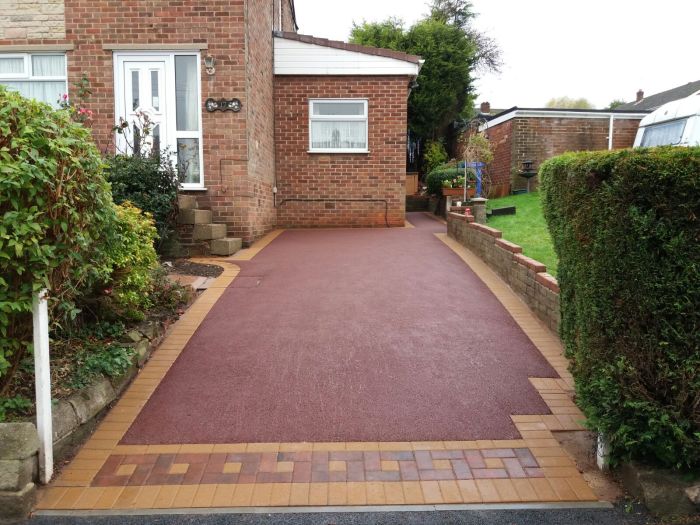Unleash your creativity and enhance your home’s exterior with tarmac driveway ideas that seamlessly blend functionality and aesthetics. From modern to traditional designs, discover a world of possibilities to transform your driveway into a captivating centerpiece.
With tarmac’s versatility and durability, you’ll not only create a visually stunning entrance but also enjoy a low-maintenance surface that withstands the test of time.
Design Options
Tarmac driveways offer a wide range of design possibilities to complement various architectural styles and personal preferences.
Patterns: Tarmac can be laid in a variety of patterns, such as herringbone, basket weave, or ashlar, adding visual interest to the driveway. Patterns can be combined to create unique and eye-catching designs.
Colors: Tarmac is typically available in black or dark gray, but can also be customized with a range of colors and finishes. Pigments can be added to the tarmac mix to achieve specific color tones, from earthy browns to vibrant reds or greens.
Textures: Tarmac can be textured to create different surface finishes, such as smooth, brushed, or exposed aggregate. Textured surfaces can enhance traction and provide a unique aesthetic appeal.
Modern Driveway Designs
- Geometric patterns: Sharp lines and angular shapes create a contemporary look, such as a herringbone pattern with contrasting colors.
- Monochrome: A sleek and minimalist approach using a single color, such as a dark gray tarmac with a smooth finish.
- Exposed aggregate: Reveals the natural stones within the tarmac, creating a textured and visually striking surface.
Traditional Driveway Designs
- Ashlar pattern: A classic and elegant pattern consisting of rectangular blocks laid in a staggered formation.
- Basket weave: A timeless pattern that resembles a woven basket, adding a touch of charm to the driveway.
- Smooth finish: A traditional and practical option, providing a uniform and easy-to-maintain surface.
Materials and Installation: Tarmac Driveway Ideas
Tarmac driveways offer durability, low maintenance, and a range of aesthetic options. Understanding the materials and installation process will help you make informed decisions for your driveway.
Tarmac, also known as asphalt, is a composite material consisting of aggregate (crushed stone), sand, and bitumen (a type of tar). Different types of tarmac materials vary in composition, texture, and performance.
Tarmac Materials
- Hot-mix asphalt (HMA): HMA is the most common type of tarmac, made with aggregate heated to high temperatures and mixed with bitumen. It provides a smooth, durable surface.
- Warm-mix asphalt (WMA): WMA uses lower temperatures during mixing, reducing emissions and energy consumption. It offers similar performance to HMA.
- Cold-mix asphalt (CMA): CMA is mixed at ambient temperatures, making it suitable for small repairs or patching. It has a rougher texture and lower durability than HMA.
- Porous asphalt: Porous asphalt allows water to drain through, reducing surface runoff and improving skid resistance. It is often used in areas with heavy rainfall.
Installation Process
Installing a tarmac driveway involves several steps:
- Site preparation: Clear the area, remove vegetation, and excavate to the desired depth. Create a solid base by compacting the subgrade.
- Laying the sub-base: Install a layer of crushed stone or gravel to provide stability and drainage.
- Applying the tarmac: Spread the tarmac material evenly over the sub-base using a paver or manually. Compact the tarmac using a roller to achieve the desired density.
- Finishing: Seal the tarmac with a sealant to protect it from water and UV rays. Consider adding markings or borders for aesthetics.
Maintenance and Repair
Maintaining your tarmac driveway is essential to prolong its lifespan and keep it looking its best. Here’s a guide to help you care for your driveway:
Cleaning
Regular cleaning removes dirt, debris, and oil spills that can damage the surface. Use a pressure washer or stiff brush with a mild detergent. Avoid harsh chemicals that can erode the tarmac.
Sealing
Sealing the driveway every few years protects it from water penetration, UV rays, and chemical spills. Apply a high-quality sealant according to the manufacturer’s instructions.
Repairs
Small cracks and holes can be repaired using a tarmac repair kit. For larger cracks or areas of damage, contact a professional for proper repairs.
Prevention
Preventative measures can help extend the lifespan of your driveway:
- Use a driveway sealer to protect the surface.
- Park vehicles on designated areas to avoid weight distribution.
- Clean spills promptly to prevent staining.
- Trim overhanging vegetation to prevent root damage.
By following these maintenance and repair tips, you can ensure your tarmac driveway stays in excellent condition for many years to come.
Drainage and Slope
Proper drainage is crucial for tarmac driveways as it prevents water accumulation and damage. Water runoff can weaken the base, leading to cracks and potholes. To ensure efficient drainage, the driveway should be sloped away from buildings and towards designated drainage channels or soakaways.
Optimal Slope, Tarmac driveway ideas
The optimal slope for a tarmac driveway is 1:40, meaning a 1-inch drop for every 40 inches of horizontal distance. This slope allows water to drain effectively without compromising vehicle traction. Achieving the correct slope during installation is essential to prevent waterlogging and maintain the driveway’s longevity.
5. Borders and Edging
Transform your tarmac driveway’s perimeter into an eye-catching feature with borders and edging. These elements define the space, add visual interest, and protect the driveway’s edges from erosion.
Materials commonly used for edging include:
Brick Edging
- Classic and durable, creating a timeless appeal.
- Available in various colors and textures to match your driveway’s aesthetic.
Concrete Edging
- Versatile and affordable, offering a clean and modern look.
- Can be customized with colors and patterns to complement your driveway.
Metal Edging
- Durable and low-maintenance, providing a sleek and contemporary touch.
- Available in various finishes, such as galvanized steel or powder-coated aluminum.
6. Lighting

Driveway lighting not only enhances safety by illuminating the path for vehicles and pedestrians, but also adds a touch of elegance and curb appeal to your property. Here are some tips for effectively lighting tarmac driveways:
Consider using a combination of ambient and task lighting. Ambient lighting provides general illumination, while task lighting focuses on specific areas like the garage entrance or mailbox. Bollard lights, path lights, and recessed lights are all popular choices for tarmac driveways.
Lighting Fixtures
- Bollard lights:These are tall, cylindrical lights that are ideal for lining driveways and walkways. They provide ambient lighting and can be fitted with decorative toppers.
- Path lights:These are low-profile lights that are placed along the edges of driveways and pathways. They provide task lighting and can be used to highlight specific features.
- Recessed lights:These are lights that are installed flush with the surface of the driveway. They provide a clean, modern look and can be used to create dramatic effects.
7. Environmental Considerations
Tarmac driveways have environmental implications, but we can minimize their impact. Using permeable or porous materials allows water to seep through, reducing runoff and erosion.
Permeable or Porous Tarmac Materials
These materials allow rainwater to infiltrate the ground, reducing surface runoff and flooding. They also help recharge groundwater and reduce the risk of soil erosion.
8. Safety Features
Tarmac driveways can be made safer by incorporating non-slip surfaces and reflective markings. Non-slip surfaces can help to prevent slips and falls, especially in wet or icy conditions. Reflective markings can help to improve visibility at night and in low-light conditions.
Non-Slip Surfaces
There are a number of different types of non-slip surfaces that can be used on tarmac driveways. Some of the most common include:
- Textured surfaces:Textured surfaces are created by adding a rough texture to the surface of the tarmac. This can be done by using a variety of techniques, such as sandblasting or rolling the tarmac with a textured roller.
- Resin-bound surfaces:Resin-bound surfaces are created by mixing resin with aggregate and then applying it to the surface of the tarmac. The resin helps to bind the aggregate together, creating a strong and durable surface that is also non-slip.
- Imprinted concrete:Imprinted concrete is created by stamping a pattern into the surface of the concrete. This can create a variety of different textures, including non-slip surfaces.
Reflective Markings
Reflective markings can be used to improve visibility at night and in low-light conditions. These markings can be applied to the surface of the tarmac using a variety of techniques, such as painting or using reflective tape.
Some of the most common types of reflective markings used on tarmac driveways include:
- Cat’s eyes:Cat’s eyes are small, reflective studs that are embedded in the surface of the tarmac. They are designed to reflect light back towards the driver, making it easier to see the driveway at night.
- Thermoplastic markings:Thermoplastic markings are made from a thermoplastic material that is applied to the surface of the tarmac. They are durable and long-lasting, and they can be used to create a variety of different shapes and patterns.
- Paint:Paint can be used to create reflective markings on tarmac driveways. However, paint is not as durable as thermoplastic markings, and it may need to be reapplied more frequently.
9. Cost and Budgeting
Installing a tarmac driveway can vary in cost depending on factors like size, materials, and labor rates. On average, expect to pay between $50 to $120 per square meter, including materials and installation. Maintenance costs can add another $20 to $40 per year.
Budgeting Tips
* Determine the size and shape of your driveway.
- Get quotes from multiple contractors and compare their prices.
- Consider the cost of materials, labor, and maintenance over the driveway’s lifespan.
- Explore financing options if needed.
10. Inspiration Gallery
Indulge in a visual journey of breathtaking tarmac driveway designs from around the globe. Experience the transformative power of tarmac as it adorns driveways in a kaleidoscope of styles, colors, and features.
Stunning Styles
From sleek and modern to rustic and charming, tarmac’s versatility knows no bounds. Witness driveways adorned with intricate patterns, geometric designs, and even custom artwork.
Last Word

Whether you seek a sleek contemporary look or a timeless classic, tarmac driveway ideas offer endless inspiration. Embrace the opportunity to design a driveway that complements your home’s architecture and reflects your personal style. By considering drainage, lighting, and safety features, you’ll create a functional and visually captivating space that enhances your home’s overall appeal.
FAQ Section
What are the advantages of using tarmac for driveways?
Tarmac driveways offer durability, low maintenance, versatility in design, and resistance to wear and tear.
How can I choose the right tarmac color for my driveway?
Consider the architectural style of your home, the surrounding landscape, and your personal preferences when selecting a tarmac color.
What is the estimated cost of installing a tarmac driveway?
The cost varies depending on factors such as the size of the driveway, the complexity of the design, and local labor rates.


